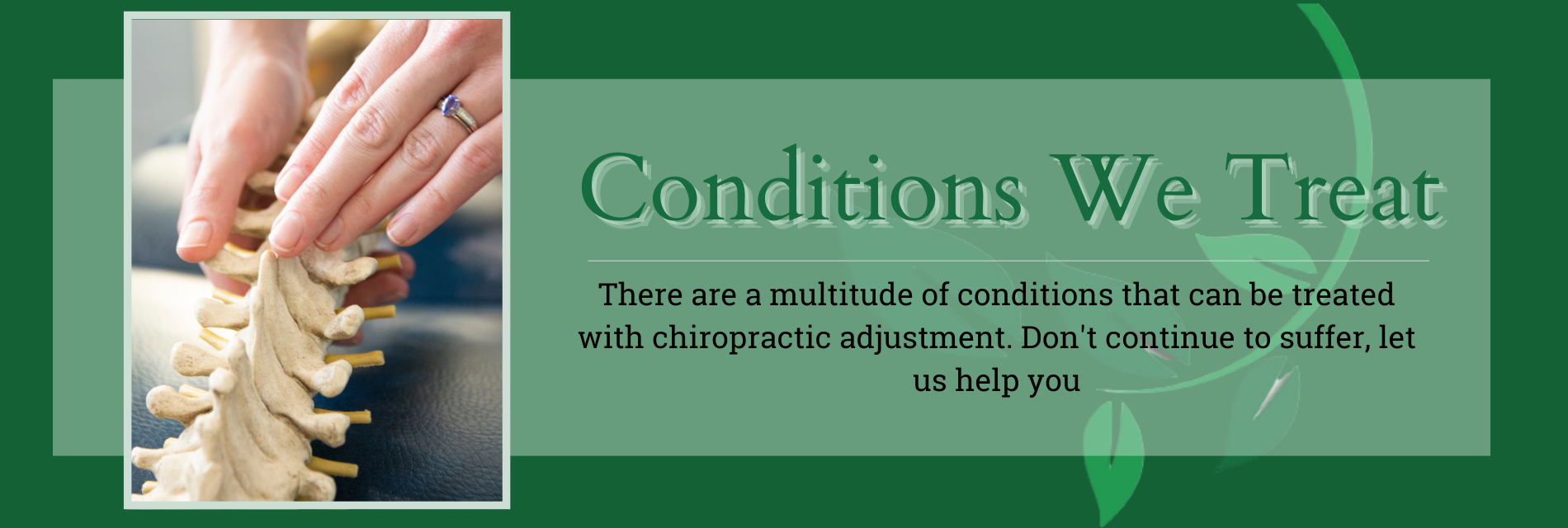
Common Examples of Conditions
Here are a few common conditions we treat. Click to discover more information, however, should you have any questions about the following or any other conditions you may have, please feel free to ask us.
 Pinched Nerve
Pinched Nerve
- Disc Herniation/Slipped disc
- Numbness, Tingling or Weakness in the Arms & Legs
A pinched nerve occurs when there is pressure or compression on a nerve, leading to pain, numbness, or weakness in the affected area. This can be caused by a variety of factors, including repetitive motions, poor posture, and injury. Common areas affected by a pinched nerve include the neck, back, wrists, and elbows.
Caused by:
- Whiplash
Creating issues like:
- Headache/Migraines
- Numbness, Tingling or Weakness in the Arms
- Vertigo
Neck pain is a common condition that refers to discomfort or pain in the cervical region of the spine, which is located in the neck. The causes of neck pain can vary and may include muscle strain, poor posture, spinal stenosis, and degenerative disc disease. Common affected areas include the neck, shoulders, and upper back, and the pain may be accompanied by stiffness, limited range of motion, and headaches.
 Mid - Upper Back Pain
Mid - Upper Back Pain
- Scoliosis
- Rounded shoulders/ posture
Mid-upper back pain refers to pain or discomfort in the thoracic region of the spine, which is located between the neck and the lower back. The causes of mid-upper back pain can vary and may include poor posture, muscle strain, spinal curvature, and spinal stenosis. Common affected areas include the middle and upper back, and the pain may be accompanied by stiffness, limited mobility, and difficulty breathing.
 Lower Back Pain
Lower Back Pain
- Sciatica
- Numbness, Tingling or Weakness in the Legs
- Degenerated Discs
- Coccydynia pain in the tailbone
Lower back pain is a common condition that refers to pain or discomfort in the lumbar region of the spine, which is located between the ribcage and the hips. The causes of lower back pain can vary and may include muscle strain, herniated discs, spinal stenosis, and arthritis. Common affected areas include the lower back, hips, and buttocks, and the pain may be accompanied by stiffness or limited mobility.
 Shoulder & Arm Issues
Shoulder & Arm Issues
- Frozen Shoulder
- Rotator Cuff injuries
- Tennis Elbow
- Carpal Tunnel Syndrome
Shoulder and arm pain is a common condition that refers to pain or discomfort in the upper extremities. The causes of shoulder and arm pain can vary and may include rotator cuff injuries, frozen shoulder, arthritis, and nerve compression. Common affected areas include the shoulder, upper arm, elbow, and wrist, and the pain may be accompanied by weakness, limited mobility, and numbness or tingling.
 Hip, Knee & Ankle Issues
Hip, Knee & Ankle Issues
- Hip Bursitis
- Plantar Fasciitis
- Ligament sprains
- Runner’s knee
Hip, knee, and ankle pain refer to discomfort or pain that occurs in the joints or surrounding muscles and tissues of the lower limb. The causes of hip, knee, and ankle pain can vary and may include arthritis, injuries, overuse, and poor biomechanics. Common affected areas include the hip joint, knee joint, ankle joint, and surrounding muscles, ligaments, and tendons. The symptoms may include pain, stiffness, swelling, and difficulty with movement or weight-bearing.
 TMJ (Jaw) Issues
TMJ (Jaw) Issues
TMJ (temporomandibular joint) issues refer to conditions that affect the jaw joint and surrounding muscles. The causes of TMJ issues can vary and may include jaw injury, teeth grinding, arthritis, and stress. Common affected areas include the jaw joint, surrounding muscles, and neck, and the symptoms may include pain, stiffness, clicking or popping sounds, and difficulty opening or closing the mouth.
 Chronic Pain Syndrome
Chronic Pain Syndrome
- Fibromyalgia
- Degenerative Joint Disease
- Arthritis
Chronic Pain Syndrome refers to a condition in which an individual experiences persistent pain lasting for several months or longer, even after an injury or underlying condition has healed. The causes of Chronic Pain Syndrome are not fully understood, but may include underlying medical conditions, injuries, nerve damage, psychological factors, or a combination of these factors. The affected areas can vary depending on the underlying condition, but commonly involve the musculoskeletal system, such as the back, neck, and joints. The symptoms may include persistent pain, fatigue, mood changes, and difficulty sleeping.
 Muscle Injuries
Muscle Injuries
Muscle injuries are damage to muscle tissue that can occur due to overuse, sudden trauma, or a variety of underlying medical conditions. Causes of muscle injuries may include physical activity, overexertion, accidents, or medical conditions such as fibromyalgia or muscular dystrophy. The affected areas can vary depending on the underlying condition, but commonly involve the muscles of the back, neck, shoulders, and legs. Symptoms may include pain, tenderness, stiffness, weakness, and reduced range of motion.
 Sports Injuries
Sports Injuries
- Tendonitis
- Sports strains and related injuries
- Runner’s knee
- Tennis Elbow
Sports injuries refer to any injury that occurs while participating in sports or exercise activities. The causes of sports injuries may include overuse, poor conditioning, insufficient warm-up, poor technique, or accidents. Commonly affected areas include the ankles, knees, shoulders, elbows, and back. Sports injuries can range from minor sprains and strains to more serious injuries such as fractures, dislocations, and torn ligaments or tendons. Symptoms may include pain, swelling, bruising, stiffness, and reduced range of motion.
 Colic/ Irritable Baby Syndrome
Colic/ Irritable Baby Syndrome
Colic or Irritable Baby Syndrome refers to excessive crying or fussiness in an otherwise healthy and well-fed infant. The exact cause of colic is unknown, but it is believed to be due to digestive issues, such as gas or acid reflux, or a reaction to certain foods or formula. Colic can affect infants from 2 weeks old up to 3 months old, and it typically occurs in the late afternoon or evening. The affected area is generally the abdomen, where the infant may experience bloating or discomfort. Colicky babies may also experience muscle spasms, and they may clench their fists, arch their backs, or pull up their knees to their chests. Chiropractic care can help relieve colic symptoms by gently manipulating the spine to reduce nerve irritation and improve the function of the digestive system.
 Pregnancy-related pain
Pregnancy-related pain
Pregnancy-related pain can occur in various areas of the body, including the lower back, hips, and pelvis. As a woman’s body changes to accommodate the growing fetus, the extra weight and pressure can cause strain on the muscles, ligaments, and joints. Hormonal changes during pregnancy can also contribute to joint laxity, which can lead to pain and discomfort. In addition, the position of the baby can put pressure on certain areas of the body, leading to pain and discomfort. Chiropractic care during pregnancy can help alleviate these symptoms by promoting proper alignment, reducing pressure on the nerves and joints, and enhancing overall function.
 General Maintenance Care and Wellness
General Maintenance Care and Wellness
- Reduces the effect of Stress and Tension
- Stiffness
- Post-surgery pain
- Joint pain and dysfunction
Chiropractic care is not just for treating specific health conditions, but it can also be used to maintain a healthy body and promote general wellness. Chiropractic adjustments can help to restore proper alignment to the spine, which can improve nerve function, enhance circulation, and promote natural healing. By ensuring that the nervous system is functioning optimally, chiropractic care can also help to strengthen the immune system, reduce stress, and improve overall energy and vitality. Additionally, chiropractors can provide advice on proper nutrition, exercise, and lifestyle habits, which can further support a healthy and balanced body. Regular chiropractic care can be an important component of a comprehensive wellness plan, helping individuals to achieve and maintain their optimal health potential.
